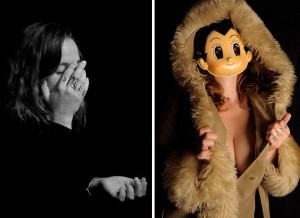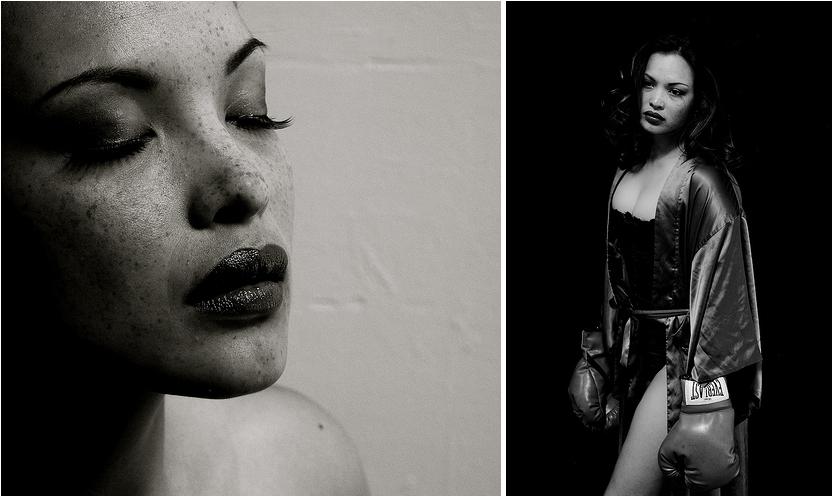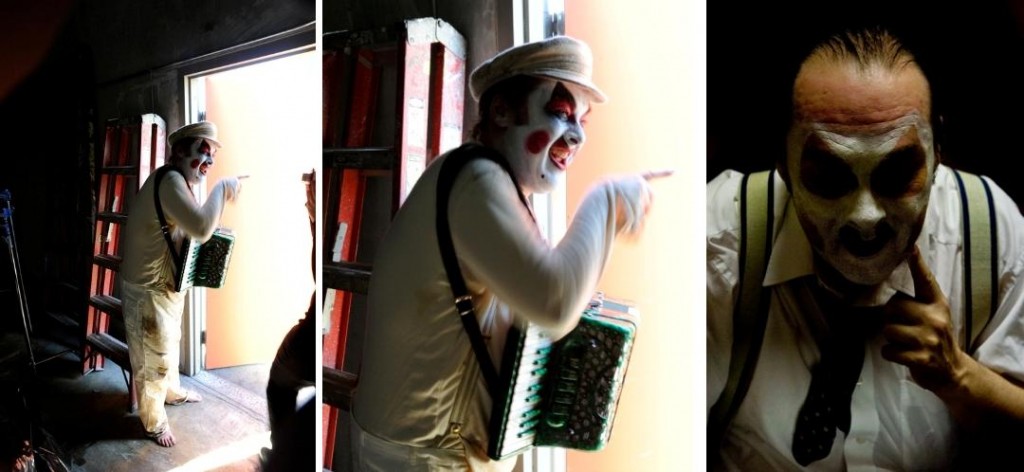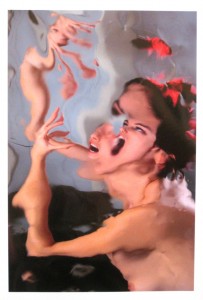Double Your Pleasure
March 23rd, 2010I often see someone at Starbucks or the grocery store I would love to photograph, but I’m too chicken to do anything about it. Not so Jaffe and Boisen, who approached prospective models in cafes and on the street. In a series of sittings that Boisen described as “very improvisational… play time,” the photographers experimented with costumes and props, “not as a fashion statement, but rather as an improvising tool or exercise to draw new identities out of the models.” Although the choice of poses and costuming were entirely the creative realm of the photographers, Jaffe graciously acknowledged that they “could not have made these images without the creative expression of [the models].”

"Amanda"
Jaffe has a knack for disarming her models. They let down their guard, appearing remarkably unselfconscious, and contemplative or joyful, allowing her to capture their humanity unfiltered. Boisen’s photos have more of a feeling that he is placing his models in a situation and infusing them with a persona he wishes to explore. A prime example is the diptych of Amanda. In Jaffe’s black-and-white take on the model, her eyes are closed, one hand over her face, the other palm up, beseeching. It is as though the model is anguishing over a decision about something abhorrent she must do. What that is may be answered by Boisen’s complement: She wears a mask which smiles from beneath the hood of a fur-trimmed coat which she is pulling open to reveal her breasts.
Although Jaffe and Boisen seem comfortable in these approaches, some of their best work is created when they switch roles. For example, Jaffe wrapped model Jonah Blue in rope and portrayed him as a B&D practitioner flipping the bird and wearing his… well it’s not his heart that’s on his sleeve. This is contrasted with Boisen’s photo where Blue is draped in black cloth, appearing as a penitent monk, atoning for his perceived sins.
In the most outstanding pairing, black-and-white photos of model Zolene, the artists switched roles in this way. Boisen’s contribution is a simple, straightforward, and understated portrait of the model with her eyes serenely closed. Jaffe on the other hand dressed Zolene in a boxer’s gloves and robe over what appears to be a black silk teddy. This image, reminiscent of Robert Mapplethorpe’s photos of Lisa Lyon, is my pick for best of show. This is the same model whose image had lured me to the “Still (In) Motion” exhibit, co-curated by Jaffe at Frisbie St. She is gorgeous, sultry, and pouting, her eyes a little sad or, perhaps, seriously focused on the proverbial prize. She could rock your world, and she could totally kick your ass. Jaffe manages to show the dichotomy in the subject within a single photo.

"Zolene"
I’m a little bit of everything
all rolled into one.
I’m a bitch, I’m a lover
I’m a child, I’m a mother
I’m a sinner, I’m a saint
I do not feel ashamed.– Meredith Brooks, “Bitch”
Occasionally both photographers took a nearly identical approach with a model. For example, their provocative portraits of Tom have him wild haired and naked but for a pair of fishnet stockings, looking for all the world like Iggy Pop. (He was at the opening and seemed like a regular guy who’s just a really good sport.) One photo was black-and-white, the other in color, one crisp, the other artfully blurred, but both essentially captured the same side of the coin. The pairing would have been more interesting if one was contrasted with something more subtle or demure, as in Jan Saudek’s “With My Third Daughter from the Second Marriage” (1987) where the diptychs’ power derives from the counterpoint of the individuals taking turns being clothed, but seemingly unaware of their varying state of undress.
It is more intriguing when the artists see the same model through radically different perspectives and follow disparate approaches. A standout diptych is the photos of Martyn Jacques. In both, the model is wearing identical clown makeup, but that is where the similarity between the portraits ends. In Boisen’s photo, Jacques has donned dirty clothes and sports an accordion. Pointing off camera, he smiles maniacally, with an overall effect that would make John Waters proud. In Jaffe’s portrait, Jacques has traded his accordion for a tie and suspenders. Leaning into the camera and jabbing his finger at the viewer instead, he is all business, a no-nonsense interrogator, an unnerving cross between Dennis Franz and John Wayne Gacy.

"Martyn Jacques" (and detail)

"Jessik"
There are some individual standouts, where the diptych did not necessarily succeed in expressing diversity but one of the photos merits particular attention. One of these is Boisen’s photo of Jessik. The model’s image appears to have been warped by a fun-house mirror. But unlike their photos of Stephanie Laursen, where the model’s eyes were stretched and reflected in similar fashion, here it does not seem like a gimmick; the composition is interesting, the colors bold and luminous, and the model–while recognizable as beautiful–has been transmogrified into an eerie likeness of Dali’s “Soft Construction with Boiled Beans (Premonition of Civil War)” (1936).
Another individual achievement is Jaffe’s portrait of Clementine Shaughnessy, which she also exhibited in “Still (In) Motion” under the title “Taggert.” Her eyes closed, palms pressed together at her lips, one gets the impression of intruding upon a private moment. As I wrote of that show, her photos “consistently but ambiguously convey their subjects’ emotional intensity. What are they feeling? Bliss? Passion? Pain?”
What are they feeling? What are we feeling? Bliss? Passion? Pain? Yes, we are.
These 13×19 archival prints are modestly priced at $100 each unframed, and $160 framed. Pricing for the diptychs is available upon inquiry. “Seeing Double” runs through April 4th at Rooz Cafe, 1918 Park Blvd, Oakland.
Michael Singman-Aste
Postdiluvian Photo
Tags: Becky Jaffe, clowns, Frisbie St., Jan Saudek, Myles Boisen, Oakland, Robert Mapplethorpe, Salvador Dali, Tiger Lillies



Leave a Reply
You must be logged in to post a comment.